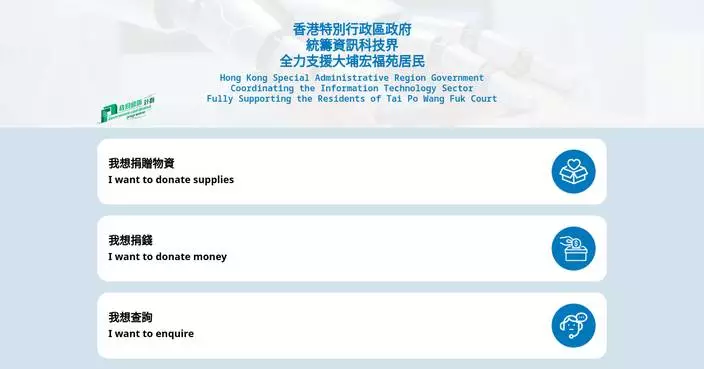Feature · News

Foggy, icy weather forces road closure in northern China

Digital technology helps Chinese online literature captivate global readers

The Central Kowloon Bypass Yau Ma Tei Section has Opened on December 21

China's 2025 animated film box office tops 25 bln yuan, hitting record high

New discoveries at China's Wuwangdun Tomb offer insights into ancient Chu culture

Glaciologist warns melting of Morteratsch Glacier in Switzerland

Russia claims capturing 2 more settlements, Ukraine claims strike on Russian frigate

Cambodia's tourism takes hit as border clashes with Thailand drag on

U.S. CPI up 2.7 pct in November, below market expectations

China's digital consumption makes up nearly half of household spending in H1: report

Chinese digital consumers value both practicality of products, sense of experience: report

Somali president reaffirms one-China principle, hails 65 years of bilateral ties with China

China to advance automotive safety standards with new draft regulations

Forum in Paris promotes China-Europe civilization dialogue

China's bio-manufacturing makes steady progress in 2021-2025 period

China's largest offshore oilfield reports record annual oil, gas output
Russia claims capturing 2 more settlements, Ukraine claims strike on Russian frigate
Cambodia's tourism takes hit as border clashes with Thailand drag on
U.S. CPI up 2.7 pct in November, below market expectations
China's digital consumption makes up nearly half of household spending in H1: report
Foggy, icy weather forces road closure in northern China
Digital technology helps Chinese online literature captivate global readers
The Central Kowloon Bypass Yau Ma Tei Section has Opened on December 21
China's 2025 animated film box office tops 25 bln yuan, hitting record high
New discoveries at China's Wuwangdun Tomb offer insights into ancient Chu culture
Glaciologist warns melting of Morteratsch Glacier in Switzerland
Chinese digital consumers value both practicality of products, sense of experience: report
Somali president reaffirms one-China principle, hails 65 years of bilateral ties with China
China to advance automotive safety standards with new draft regulations
Forum in Paris promotes China-Europe civilization dialogue
China's bio-manufacturing makes steady progress in 2021-2025 period
China's largest offshore oilfield reports record annual oil, gas output
Feature·Bloggers

【Deep Blue】Trump's "Empire Strikes Back" Gambit: A Long Shot at Best

【What Say You?】Unfinished business With the “anti-Hong Kong triangle”?

【Bastille Commentary】UK's Hypocrisy on Display: Seizing Private Assets While Preaching Freedom

【What Say You?】London’s Selective Memory on National Security

【What Say You?】The “Shina-Implosion” Playbook Behind Jimmy Lai

【Ariel】Insider Breaks Silence: 2019 Was Orchestrated — And He Names Who Pulled the Strings

Top Trump administration official defends partial release of Epstein files as Democrats cry foul
- Power restored to most in San Francisco after massive outage
- Thousands cheer as the sun rises on winter solstice at Stonehenge
- SHAREHOLDER INVESTIGATION: Faruqi & Faruqi, LLP Examining Potential Securities Law Violations at The Wildermuth Fund
- Multiple gunmen open fire at a South African pub, killing 9 and wounding 10
- SHAREHOLDER INVESTIGATION: Faruqi & Faruqi, LLP Examining Potential Securities Law Violations at Synopsys
- SHAREHOLDER INVESTIGATION: Faruqi & Faruqi, LLP Examining Potential Securities Law Violations at Alexandria Real Estate Equities
- SHAREHOLDER INVESTIGATION: Faruqi & Faruqi, LLP Examining Potential Securities Law Violations at Sprouts Farmers Market
- TVRD INVESTOR NOTICE: Faruqi & Faruqi, LLP Investigates Claims on Behalf of Investors of Tvardi Therapeutics
- Israel's Cabinet approves 19 new Jewish settlements in the occupied West Bank

Hainan records 161 mln yuan in duty-free sales on first day of special customs operations
- Gaza humanitarian crisis worsens as Israeli strikes continue
- Guangzhou Baiyun Int'l Airport sees 19 pct rise in cross-border travel this year
- Student from Dominican Republic shares colorful experience traveling around China
- China International Travel Mart wraps up in Hainan
- Foreign trade in Yangtze River Economic Belt hits 19 tln yuan in first 11 months
- China steps up effort to foster childcare-friendly environment
- Cold weather conditions drive demand for home textiles
- Event in celebration of Dong New Year held at Zhaoxing Dong village
- Preparation for 38th int’l snow sculpture art expo enters final stage in Harbin

Trump's return brought stiff headwinds for clean energy. So why are advocates optimistic in 2026?
- Netflix and Paramount are fighting over Warner Bros. Discovery. Here's the regulatory outlook
- PHOTO ESSAY: Tibetans depart Nepal, a former safe haven transformed under Chinese pressure
- Iraq's political future in limbo as factions vie for power
- In-Demand Employment Sectors: SIM Equips Singapore’s Workforce for the Future Economy
- Saudi Arabia quietly expands access to its only alcohol store for non-Muslim residents
- The Grand Opening of Dreame Hong Kong Flagship Store Showcases Full Product Lineup
- Christmas at Arspura: Year-End Savings and a New Range Hood Lineup
- SIM Graduates Demonstrate Strong Employment Outcomes in High-Demand Sectors
- Photos show mock funeral for the penny at Lincoln Memorial

These influencers are teaching Christianity online — and young people are listening
- PHOTO ESSAY: Invisible infrared surveillance technology and those caught in its digital cage
- How surveillance technology and the 'Reddit Detective Agency' helped search for a killer
- You finally got a doctor's appointment. Here's how to get the most out of it
- PHOTO ESSAY: Under watch by Chinese tech, the Tibetan community in Nepal is slowly suffocating
- US awards no-bid contract to Denmark scientists studying hepatitis B vaccine in African babies
- The shortest day of the year is descending on the Northern Hemisphere. Here's what to know
- One Tech Tip: Spend quality time with loved ones, not a screen, over the holidays
- Saturn's moon Titan may not have a buried ocean as long suspected, new study suggests
- Hyundai and Kia will repair millions of vehicles under a deal to fix anti-theft technology

Prince William brings his son to the same homeless shelter he first visited with Princess Diana
- Tearful Bowen Yang departs 'SNL' after emotional Christmas episode hosted by Ariana Grande
- Everything you need to know about Christmas, and how it has evolved into a global holiday
- Children's author David Walliams denies inappropriate behavior after publisher drops him
- NORAD continues decades-long tradition of tracking Santa's trip around the world
- Judge nixes conviction of 1 of 2 men found guilty of killing Run-DMC's Jam Master Jay
- Oscar contender ‘The Secret Agent’ capitalizes on the rise of Brazilian cinema
- Pete Davidson and Elsie Hewitt welcome their 'perfect angel girl'
- Sony buys a majority stake in the 'Peanuts' comic for $457 million from Canada's WildBrain
- '6-7,' Dubai chocolate, Labubu: You took 2025, now scat!

Jack Hughes is returning for the Devils just over 5 weeks since finger surgery
- White Sox add Munetaka Murakami with $34 million, 2-year contract
- The Commanders showed more fight during a late brawl with the Eagles than during many games
- Excitement building as Morocco prepares to open 35th Africa Cup of Nations against Comoros
- Sabres GM Jarmo Kekalainen reshapes front office by hiring Marc Bergevin and Josh Flynn
- Jalen Hurts and the Eagles win their second NFC East title in a row by beating the Commanders 29-18
- Marco wins! Schwarz scores World Cup giant slalom victory with favored Marco Odermatt sixth
- Barcelona defender Christensen faces long spell out after tearing ACL in left knee at training
- Ryan Gerard flew across two oceans to play in Mauritius. It paid off with a Masters invitation
- Sofia Goggia gets overdue World Cup win in super-G and Lindsey Vonn is third

Government Task Forces Mobilize $4 Billion for Wang Fuk Court Fire Relief Efforts in Tai Po
- Hong Kong Customs Seizes 5kg of Cannabis at Airport, Arrests 23-Year-Old Passenger from Bangkok
- Transport Department Enhances Services for Residents Affected by Tai Po Fire and Transitional Housing Needs
- No New Chikungunya Cases in Hong Kong; Tsing Yi Trails Closed for Mosquito Control Efforts
- HA Addresses Concerns Over Healthcare Fee Reforms and Expands Medical Waivers for Vulnerable Populations.
- Smart training aids rehabilitation
- Smart Geriatric Day Hospital Project Transforms Rehabilitation for 350 Patients with Innovative Home Training
- Hong Kong Customs Seizes 12kg of Smuggled Cattle Gallstones Worth $13.78 Million at Border Control Point
- Health Authorities Investigate Meningococcal Infection Case, Urge Public to Practice Hygiene
- Government Task Forces Provide Support and Investigation After Wang Fuk Court Fire in Tai Po

Visa-free policy boosts inbound tourism in north China border city
- Resort island in south China's Guangxi draws more tourists with diverse recreational activities
- China grants first L3 autonomous driving license plate in southwestern city
- Deep-sea archaeological exhibition in Beijing displays relics recovered from shipwreck
- People across China enjoy traditional delicacies during Winter Solstice
- Avatar themes reflect universal values amid real-world divisions: director
- China builds care network for elderly people lost mobility
- Cold wave brings snowfall to high-altitude parts of southwest China's Chongqing
- Chinese Naval hospital ship arrives in Barbados for friendly visit, medical aid
- Multimodal transport in China opens new int'l logistics channels
Category · News

Jack Hughes is returning for the Devils just over 5 weeks since finger surgery

Top Trump administration official defends partial release of Epstein files as Democrats cry foul

White Sox add Munetaka Murakami with $34 million, 2-year contract

The Commanders showed more fight during a late brawl with the Eagles than during many games

Excitement building as Morocco prepares to open 35th Africa Cup of Nations against Comoros

Power restored to most in San Francisco after massive outage

Sabres GM Jarmo Kekalainen reshapes front office by hiring Marc Bergevin and Josh Flynn

Jalen Hurts and the Eagles win their second NFC East title in a row by beating the Commanders 29-18

Thousands cheer as the sun rises on winter solstice at Stonehenge

SHAREHOLDER INVESTIGATION: Faruqi & Faruqi, LLP Examining Potential Securities Law Violations at The Wildermuth Fund

Multiple gunmen open fire at a South African pub, killing 9 and wounding 10

SHAREHOLDER INVESTIGATION: Faruqi & Faruqi, LLP Examining Potential Securities Law Violations at Synopsys

SHAREHOLDER INVESTIGATION: Faruqi & Faruqi, LLP Examining Potential Securities Law Violations at Alexandria Real Estate Equities

SHAREHOLDER INVESTIGATION: Faruqi & Faruqi, LLP Examining Potential Securities Law Violations at Sprouts Farmers Market

TVRD INVESTOR NOTICE: Faruqi & Faruqi, LLP Investigates Claims on Behalf of Investors of Tvardi Therapeutics

Israel's Cabinet approves 19 new Jewish settlements in the occupied West Bank

SHAREHOLDER INVESTIGATION: Faruqi & Faruqi, LLP Examining Potential Securities Law Violations at Blue Owl Capital

SHAREHOLDER INVESTIGATION: Faruqi & Faruqi, LLP Examining Potential Securities Law Violations at Inspire Medical Systems

DEADLINE ALERT: Faruqi & Faruqi, LLP Investigates Claims on Behalf of Investors of Rezolute

Russia says talks on US peace plan for Ukraine 'are proceeding constructively'

NJDCY INVESTOR ALERT: Faruqi & Faruqi, LLP Investigates Claims on Behalf of Investors of Nidec

SHAREHOLDER INVESTIGATION: Faruqi & Faruqi, LLP Examining Potential Securities Law Violations at StubHub

Turning Point showcases the discord that Republicans like Vance will need to navigate in the future

SHAREHOLDER INVESTIGATION: Faruqi & Faruqi, LLP Examining Potential Securities Law Violations at Bitdeer Technologies

SHAREHOLDER INVESTIGATION: Faruqi & Faruqi, LLP Examining Potential Securities Law Violations at Primo Brands

Prince William brings his son to the same homeless shelter he first visited with Princess Diana

SHAREHOLDER INVESTIGATION: Faruqi & Faruqi, LLP Examining Potential Securities Law Violations at Avantor

Marco wins! Schwarz scores World Cup giant slalom victory with favored Marco Odermatt sixth

Barcelona defender Christensen faces long spell out after tearing ACL in left knee at training
Hainan records 161 mln yuan in duty-free sales on first day of special customs operations

These influencers are teaching Christianity online — and young people are listening

Trump's return brought stiff headwinds for clean energy. So why are advocates optimistic in 2026?

Netflix and Paramount are fighting over Warner Bros. Discovery. Here's the regulatory outlook
Gaza humanitarian crisis worsens as Israeli strikes continue

Ryan Gerard flew across two oceans to play in Mauritius. It paid off with a Masters invitation

Government Task Forces Mobilize $4 Billion for Wang Fuk Court Fire Relief Efforts in Tai Po

Sofia Goggia gets overdue World Cup win in super-G and Lindsey Vonn is third

Trump is leaning on son-in-law Jared Kushner for difficult diplomacy

PHOTO ESSAY: Tibetans depart Nepal, a former safe haven transformed under Chinese pressure
Guangzhou Baiyun Int'l Airport sees 19 pct rise in cross-border travel this year

Thousands gather at Bondi Beach to mourn victims of antisemitic attack

Hong Kong Customs Seizes 5kg of Cannabis at Airport, Arrests 23-Year-Old Passenger from Bangkok

Élysée Palace silver steward arrested for stealing thousands of euros' worth of silverware

Transport Department Enhances Services for Residents Affected by Tai Po Fire and Transitional Housing Needs
Student from Dominican Republic shares colorful experience traveling around China
China International Travel Mart wraps up in Hainan
Foreign trade in Yangtze River Economic Belt hits 19 tln yuan in first 11 months
Cold weather conditions drive demand for home textiles
China steps up effort to foster childcare-friendly environment
Event in celebration of Dong New Year held at Zhaoxing Dong village
Preparation for 38th int’l snow sculpture art expo enters final stage in Harbin
Visa-free policy boosts inbound tourism in north China border city
Resort island in south China's Guangxi draws more tourists with diverse recreational activities

No New Chikungunya Cases in Hong Kong; Tsing Yi Trails Closed for Mosquito Control Efforts
China grants first L3 autonomous driving license plate in southwestern city
People across China enjoy traditional delicacies during Winter Solstice
Deep-sea archaeological exhibition in Beijing displays relics recovered from shipwreck
Avatar themes reflect universal values amid real-world divisions: director
China builds care network for elderly people lost mobility
Cold wave brings snowfall to high-altitude parts of southwest China's Chongqing
Chinese Naval hospital ship arrives in Barbados for friendly visit, medical aid
Multimodal transport in China opens new int'l logistics channels
Ice-snow events ignite winter tourism fever in northwest China's Gansu
China's first AI-generated animated movie hits big screen
Success of 'Zootopia 2' in China shows power of strong storytelling: Hollywood producer
Mainland, Taiwan racers gather in Xiamen for year-end motorsport showdown
Jordan hosts first official drag race to promote motorsport, tourism
Exhibition of artworks by Chinese, Italian artists opens in Chengdu

Bazball revolution falters for England in the Ashes, but it's not the end of the system

Iraq's political future in limbo as factions vie for power
Ice-snow theme park in northeast China's Changchun opens to public
Passenger flow tops 100,000 on Quanzhou-Kinmen ferry route

In-Demand Employment Sectors: SIM Equips Singapore’s Workforce for the Future Economy
Xinjiang's fresh produce hits Central Asian markets within 30 hours

How the 'worst' Australian team in 15 years just retained the Ashes against England

HA Addresses Concerns Over Healthcare Fee Reforms and Expands Medical Waivers for Vulnerable Populations.
Canoeing competition on Nujiang River opens in southwest China's Yunnan

Photos of Turning Point USA's annual conservative youth conference
China welcomes Winter Solstice with flavors of home

Payton Pritchard scores 33 points as short-handed Celtics beat slumping Raptors 112-96

Jordan Love exits Green Bay loss with a concussion in latest injury for Packers

Luka Doncic exits Lakers loss with leg injury
Bedding sales soar in Shanghai as temperatures drop

Here's what you missed at Turning Point's chaotic convention






































